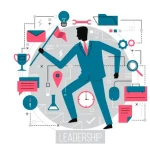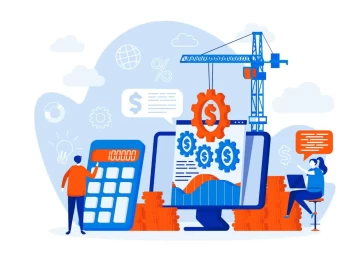Introduction
Organizational culture is the invisible force that shapes an organization's identity, values, and behaviors. It encompasses elements such as values, beliefs, norms, traditions, communication styles, leadership approaches, and more. Understanding what constitutes organizational culture is vital for organizations aiming to foster a positive and cohesive work environment that aligns with their goals and values. In this article, we'll delve into the fundamental components of organizational culture, explore its importance, and examine the role of leadership in shaping and sustaining a strong organizational culture.
What are the Fundamental Components of Organizational Culture?
The fundamental components of organizational culture can be broken down into several key elements that collectively shape the identity, values, and behaviors within an organization. These components include:
- Values: Core values are the fundamental beliefs and principles that guide the organization's decisions, actions, and interactions. They represent what the organization stands for and what it considers important. For example, values such as integrity, innovation, customer focus, or teamwork are common components of organizational culture.
- Beliefs and Assumptions: Beliefs and assumptions are the underlying convictions and expectations that influence how individuals within the organization perceive reality, interpret events, and make decisions. These beliefs shape attitudes, behaviors, and norms within the organizational context.
- Norms: Norms are the unwritten rules, expectations, and standards of behavior that govern how employees should act and interact within the organization. Norms can include aspects such as communication styles, work ethic, collaboration approaches, and problem-solving methods.
- Symbols and Artifacts: Symbols and artifacts are visible manifestations of organizational culture. They include tangible elements such as logos, mission statements, office layout, dress code, rituals, ceremonies, and shared stories. These symbols and artifacts convey messages about the organization's identity, values, history, and norms.
- Language and Communication: Language plays a crucial role in organizational culture. This includes not only the words and terminology used but also the communication styles, tone, and channels employed within the organization. The language used reflects and reinforces the cultural norms, values, and expectations.
- Leadership Style: Leadership style and behavior significantly impact organizational culture. Leaders shape and influence culture through their actions, decisions, priorities, and interactions with employees. Effective leaders align their leadership approach with the organization's values and foster a culture of trust, transparency, and accountability.
- Organizational Structure and Processes: The organizational structure, hierarchy, decision-making processes, and workflow systems contribute to the overall culture. Structures that promote autonomy, collaboration, and innovation can foster a positive culture, while rigid or bureaucratic structures may inhibit cultural adaptability and creativity.
- Employee Behavior and Attitudes: Ultimately, organizational culture is reflected in the attitudes, behaviors, and actions of employees at all levels. Employee engagement, motivation, commitment, and alignment with the organization's values are key indicators of a healthy organizational culture.
By understanding and addressing these fundamental components, organizations can cultivate a strong and positive organizational culture that supports their mission, vision, and long-term success.
What are the Key Metrics and Indicators of a Strong Organizational Culture?
Measuring organizational culture involves assessing various qualitative and quantitative metrics that reflect the health, alignment, and effectiveness of the culture within an organization. Here are some key metrics and indicators commonly used to evaluate a strong organizational culture:
- Employee Engagement:
- Employee Surveys: Regular surveys can gauge employees' level of engagement, satisfaction, and commitment to the organization. Questions may focus on aspects such as job satisfaction, alignment with organizational values, opportunities for growth, and overall morale.
- Retention Rates: High retention rates indicate that employees are satisfied, engaged, and likely aligned with the organization's culture. Low turnover suggests a strong culture that fosters employee loyalty and commitment.
- Leadership Effectiveness:
- 360-Degree Feedback: Evaluating leadership effectiveness through feedback from peers, subordinates, and supervisors can provide insights into leadership behaviors, communication styles, and alignment with cultural values.
- Leadership Development Program Success: Assessing the impact of leadership development initiatives on improving leadership skills, fostering a positive culture, and driving organizational performance can be indicative of a strong culture.
- Organizational Communication:
- Communication Effectiveness: Evaluating the clarity, transparency, and frequency of communication within the organization can indicate the strength of communication channels and their alignment with cultural values such as openness and honesty.
- Feedback Mechanisms: Monitoring the existence and effectiveness of feedback mechanisms, such as suggestion boxes, town hall meetings, or anonymous feedback platforms, can reflect the organization's commitment to listening, learning, and continuous improvement.
- Cultural Alignment:
- Value Alignment: Assessing the extent to which employees' behaviors, decisions, and actions align with the organization's core values and mission can indicate cultural alignment.
- Behavioral Consistency: Consistency in behaviors, norms, and practices across different teams, departments, and levels of the organization can indicate a strong and cohesive culture.
- Innovation and Adaptability:
- Innovation Metrics: Tracking metrics related to innovation, such as the number of new ideas generated, successful implementation of innovations, and impact on business outcomes, can reflect a culture that values creativity and innovation.
- Change Readiness: Assessing employees' readiness and ability to adapt to change, embrace new initiatives, and overcome challenges can indicate the organization's adaptability and resilience.
- Customer and Stakeholder Satisfaction:
- Customer Feedback: Monitoring customer feedback, satisfaction scores, and loyalty metrics can reflect how well the organization's culture translates into positive customer experiences and relationships.
- Stakeholder Engagement: Assessing stakeholders' perceptions, trust levels, and engagement with the organization can indicate the effectiveness of the culture in building strong external relationships.
- Performance and Results:
- Key Performance Indicators (KPIs): Linking cultural initiatives to key performance indicators, such as productivity, profitability, quality metrics, and market share, can demonstrate the impact of culture on driving business results.
- Employee Performance Reviews: Evaluating employee performance against cultural values and behaviors can reinforce the importance of cultural alignment in driving individual and organizational success.
Table 1: The key metrics and indicators of a strong organizational culture
Metric/Indicator | Description |
Employee Engagement | Surveys measuring engagement, satisfaction, alignment with values, opportunities for growth, and overall morale. |
Retention Rates | High rates indicate employee satisfaction, loyalty, and alignment with culture. |
Leadership Effectiveness | 360-degree feedback on leadership behaviors, communication, and alignment with cultural values. |
Communication Effectiveness | Clarity, transparency, and frequency of communication, and alignment with cultural values. |
Feedback Mechanisms | Effectiveness of feedback mechanisms such as suggestion boxes or town hall meetings. |
Cultural Alignment | Assessment of behavior alignment with core values and mission. |
Innovation Metrics | Tracking new ideas, successful implementation, and impact on business outcomes. |
Change Readiness | Employees' ability to adapt, embrace initiatives, and overcome challenges. |
Customer Feedback | Monitoring customer satisfaction, loyalty, and experiences related to culture. |
Stakeholder Engagement | Assessing stakeholders' perceptions, trust, and engagement with the organization. |
Key Performance Indicators (KPIs) | Linking cultural initiatives to productivity, profitability, quality metrics, and market share. |
Employee Performance Reviews | Evaluating performance against cultural values and behaviors. |
These metrics and indicators provide a comprehensive framework for assessing the strength, alignment, and impact of organizational culture on various aspects of organizational performance and effectiveness. Organizations may customize and combine these metrics based on their specific cultural goals, priorities, and context.
What Role Does Leadership Play in Shaping Organizational Culture?
Leadership plays a crucial role in shaping organizational culture as leaders are instrumental in defining, promoting, and reinforcing the values, behaviors, and norms that form the cultural fabric of an organization. Here are key roles that leadership plays in shaping organizational culture:
- Setting the Tone: Leaders set the tone for organizational culture through their actions, decisions, and behaviors. Their words and actions signal what is valued, accepted, and expected within the organization, influencing how employees perceive and adopt cultural norms.
- Defining Core Values: Leaders articulate and reinforce the organization's core values, mission, and vision, providing a clear direction and purpose for employees. By consistently aligning decisions and initiatives with these values, leaders shape the cultural identity and priorities of the organization.
- Modeling Behaviors: Leaders serve as role models for desired behaviors and cultural norms. When leaders embody the values they espouse, demonstrate integrity, promote collaboration, and exhibit empathy, they inspire employees to emulate these behaviors, contributing to a positive culture.
- Communicating Expectations: Leaders communicate expectations regarding performance, conduct, and cultural alignment, clarifying what behaviors and attitudes are valued and rewarded within the organization. Effective communication channels facilitate transparency, trust, and shared understanding of cultural expectations.
- Creating a Supportive Environment: Leaders create an environment that supports cultural initiatives, learning, and innovation. By fostering open communication, encouraging feedback, providing resources, and promoting psychological safety, leaders enable employees to contribute to cultural evolution and adaptation.
- Driving Change and Adaptability: Leaders play a critical role in driving cultural change, adapting to external challenges, and fostering organizational agility. They champion initiatives that promote cultural evolution, address cultural gaps, and facilitate change management processes effectively.
- Building Trust and Engagement: Leaders build trust, rapport, and rapport with employees through authentic leadership, active listening, and inclusive decision-making. Trusting relationships foster employee engagement, loyalty, and commitment to the organization's culture and goals.
- Promoting Diversity and Inclusion: Leaders promote diversity, equity, and inclusion by championing inclusive practices, embracing diverse perspectives, and creating opportunities for all employees to contribute and thrive. Inclusive leadership strengthens cultural diversity and fosters a sense of belonging within the organization.
- Aligning Strategies with Culture: Leaders ensure that organizational strategies, policies, and initiatives are aligned with the desired culture, avoiding conflicts or inconsistencies that may undermine cultural cohesion. Strategic alignment reinforces cultural values and reinforces their importance in achieving organizational objectives.
- Evaluating and Reinforcing Culture: Leaders regularly assess and evaluate the organization's culture, gathering feedback, measuring cultural indicators, and identifying areas for improvement. They take proactive steps to reinforce positive aspects of the culture, address cultural gaps, and promote continuous cultural development.
Table 2: The key roles of leadership in shaping organizational culture
Leadership Role | Description |
Setting the Tone | Leaders influence culture through their actions, signaling what is valued and expected within the organization. |
Defining Core Values | Leaders articulate and reinforce the organization's values, mission, and vision, providing a clear direction for employees. |
Modeling Behaviors | Leaders serve as role models for desired behaviors, encouraging employees to emulate values like integrity and collaboration. |
Communicating Expectations | Leaders clarify expectations for performance, conduct, and cultural alignment, fostering transparency and trust. |
Creating a Supportive Environment | Leaders create an environment conducive to cultural initiatives, innovation, and learning, promoting open communication and feedback. |
Driving Change and Adaptability | Leaders champion cultural change, fostering agility and resilience in response to challenges and opportunities. |
Building Trust and Engagement | Leaders build trust and rapport with employees, fostering engagement, loyalty, and commitment to cultural values. |
Promoting Diversity and Inclusion | Leaders champion diversity, equity, and inclusion, creating an environment where all employees can thrive. |
Aligning Strategies with Culture | Leaders ensure organizational strategies align with cultural values, reinforcing their importance in achieving objectives. |
Evaluating and Reinforcing Culture | Leaders assess and reinforce the organization's culture, addressing gaps and promoting continuous improvement.
|
Overall, leadership plays a pivotal role in shaping organizational culture by embodying cultural values, fostering alignment, creating a supportive environment, driving change, building trust, promoting diversity and inclusion, aligning strategies, and evaluating cultural effectiveness. Effective leadership ensures that organizational culture reflects the organization's identity, supports its goals, and enhances employee engagement, performance, and well-being.
Conclusion
In conclusion, organizational culture is a dynamic and influential aspect of every organization. It encompasses a variety of components, including values, beliefs, norms, traditions, communication styles, and leadership approaches. A strong organizational culture that is aligned with the organization's goals and values can lead to improved employee engagement, productivity, innovation, adaptability, customer satisfaction, and overall performance. Leadership plays a crucial role in shaping and sustaining this culture, as leaders set the tone, define core values, model behaviors, communicate expectations, create a supportive environment, drive change, promote diversity and inclusion, align strategies, and evaluate cultural effectiveness. By understanding, nurturing, and leveraging organizational culture, organizations can create a positive work environment that fosters employee well-being, organizational success, and long-term sustainability.

























